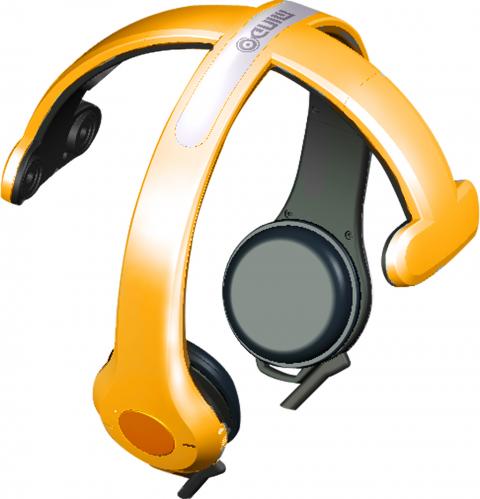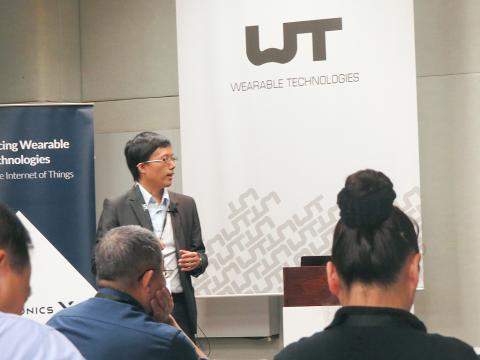In a world that might be around the corner, an elderly widower can continue his relationship with a dearly departed spouse. He turns on the television and there she is in high-definition, gesturing and talking back and even breathing in the way she had in real life.
Steve Huang (黃宏旭), vice president of Taiwan’s AiQ Smart Clothing, said the idea isn’t at all farfetched. The technology required includes an intelligent software application like Siri, voice recording and video, all currently available. Smart clothing, which the couple wears during life, can unobtrusively capture a wealth of biofeedback that is later used to build a convincing hologram.
“We offer enabling technology. A service company can come in and pull all the tools together and you get a virtual spouse,” Huang said.

Photo Courtesy of Brain Rhythm Inc.
“Or, if you are already tired of the old guy, you can choose a very handsome actor or a very sexy lady.”
Huang is a new player in wearable technologies, one of the tech world’s fast-growing sectors.
In the US, funding in wearables grew 80 percent between 2012 and last year, and rose another 38 percent this year in the first four months alone, according to latest available data from analyst firm CB Insight.

Photo Courtesy of Brain Rhythm Inc.
“This field is a very big opportunity … We got serious about smart clothing one, two years ago. Thought the time was ripe,” said Huang, whose professional experience had been in metal fiber technologies.
The global wearables market is now filled with formidable giants like Google with Google Glass and Apple with Apple Watch, plus startups with products ranging from a ring that turns pages in an e-book reader to a hairband that sends out an SOS call when it senses the user is under assault.
WARMING TO WEARABLES

Photo Courtesy of AiQ Smart Clothing
In Taiwan, the tech sector is warming to the concept. Both Acer, HTC and Asus have announced interest in entering the wearables market, and rumors are that Asus will launch ZenWatch in Taiwan next month.
Local startups, too, are eyeing a slice of the market. At Taipei’s Wearables Technologies Conference earlier this month, Rooti Labs CEO Michael Lee (黎克邁) brought two devices: W/Me, a bluetooth enabled “breathing coach” for mental health; and CliMate, a wearable “Personal Weatherman” that monitors humidity, UV index and temperature.
From Hsinchu Science Park, general manager Lu Shao-wei (呂紹瑋) of Brain Rhythm Inc. announced the release of the first made-in-Taiwan brain monitoring headset, which retails to developers for US$899 at the end of the month.

Photo Courtesy of AiQ Smart Clothing
Traditional brain recorders use wet sensors that require direct contact with the scalp to achieve a signal, Lu said.
Since their new device uses dry electrodes, as well as Bluetooth data transmission, it can record brain activity while sitting on top of a head like a hat. It can also be worn outside of the lab, which opens up a range of daily-life applications, he said.
At work, it can detect drowsiness and alarm the user. In the morning, it can detect the health of the brain and what it needs to be in tip-top form.

Photo: Enru lin, taipei times
“When you don’t know what breakfast to buy, EEG can help you to detect what you should buy today,” he said.
Sounds like a godsend, or maybe not. Skepticism over wearables mainly comes down to worries that the devices can get invasive.
Huang, who believes smart clothing can save lives if bus drivers are required to wear them, said Taiwanese society at large may not yet be prepared to embrace his shirts.
“It’s a legal issue. The laws are strict, society is conservative,” he said.
“Taiwan’s market might take some time to develop. But wearables should be popular everywhere, sooner or later.”

May 26 to June 1 When the Qing Dynasty first took control over many parts of Taiwan in 1684, it roughly continued the Kingdom of Tungning’s administrative borders (see below), setting up one prefecture and three counties. The actual area of control covered today’s Chiayi, Tainan and Kaohsiung. The administrative center was in Taiwan Prefecture, in today’s Tainan. But as Han settlement expanded and due to rebellions and other international incidents, the administrative units became more complex. By the time Taiwan became a province of the Qing in 1887, there were three prefectures, eleven counties, three subprefectures and one directly-administered prefecture, with

Taiwan Power Co (Taipower, 台電) and the New Taipei City Government in May last year agreed to allow the activation of a spent fuel storage facility for the Jinshan Nuclear Power Plant in Shihmen District (石門). The deal ended eleven years of legal wrangling. According to the Taipower announcement, the city government engaged in repeated delays, failing to approve water and soil conservation plans. Taipower said at the time that plans for another dry storage facility for the Guosheng Nuclear Power Plant in New Taipei City’s Wanli District (萬里) remained stuck in legal limbo. Later that year an agreement was reached

What does the Taiwan People’s Party (TPP) in the Huang Kuo-chang (黃國昌) era stand for? What sets it apart from their allies, the Chinese Nationalist Party (KMT)? With some shifts in tone and emphasis, the KMT’s stances have not changed significantly since the late 2000s and the era of former president Ma Ying-jeou (馬英九). The Democratic Progressive Party’s (DPP) current platform formed in the mid-2010s under the guidance of Tsai Ing-wen (蔡英文), and current President William Lai (賴清德) campaigned on continuity. Though their ideological stances may be a bit stale, they have the advantage of being broadly understood by the voters.

In a high-rise office building in Taipei’s government district, the primary agency for maintaining links to Thailand’s 108 Yunnan villages — which are home to a population of around 200,000 descendants of the Chinese Nationalist Party (KMT) armies stranded in Thailand following the Chinese Civil War — is the Overseas Community Affairs Council (OCAC). Established in China in 1926, the OCAC was born of a mandate to support Chinese education, culture and economic development in far flung Chinese diaspora communities, which, especially in southeast Asia, had underwritten the military insurgencies against the Qing Dynasty that led to the founding of